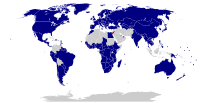
Photo from wikipedia
Introduction: Hemorrhage is the leading cause of potentially preventable death on the battlefield. We previously published data defining the pediatric massive transfusion at 40mL/kg of total blood products. However, there… Click to show full abstract
Introduction: Hemorrhage is the leading cause of potentially preventable death on the battlefield. We previously published data defining the pediatric massive transfusion at 40mL/kg of total blood products. However, there is a subset of casualties that require large volumes of blood products - super massive transfusions - which remains unclear. We seek to determine what defines a super massive transfusion within the pediatric population as understanding this unique group would help mobilize resources early in their clinical course. Methods: This is a secondary analysis of a previously described dataset from the Department of Defense Trauma Registry. In this analysis, we sought all casualties within our dataset that met inclusion for MT. To describe the super MT, we sought the top quartile of total products administered within the first 24 hours on a volume per weight basis. Results: Within our original dataset of 3439 pediatric casualties, we identified 543 that met inclusion for massive transfusion, with the 75th percentile at 120.6 mL/kg - we rounded this to 120mL/kg for simplicity which left 137 for analysis. Most of the casualties were in the 5-9 and 10-14 age groups (24% and 39%, respectively) and were most frequently injured by explosive (71%). Those in the super MT group had lower survival (75% versus 84%, p=0.015), longer ventilator courses (median 3 days versus 2 days, p=0.029) despite similar median injury severity scores (17 versus 17, p=0.100). However, they more frequently had serious injuries to the extremities (62% versus 35%, p<0.001). Super MT casualties more frequently had age-adjusted hypotension (45% versus 26%, p<0.001) but no difference in age-adjusted tachycardia (88% versus 86%, p=0.514). Super MT casualties had worse international normalized ratios (2.06 versus 1.65, p=0.006), and worse base deficits (-11.3 versus -8.5, p<0.001). Conclusions: In our analysis, we found that 120 mL/kg of total blood products administered within the first 24 hours was the threshold for the top 25th percentile of pediatric blood product consumers. More data is needed to define this unique population that requires mobilization of extensive resources. No relevant conflicts of interest to declare.
Journal Title: Blood
Year Published: 2020
Link to full text (if available)
Share on Social Media: Sign Up to like & get
recommendations!